5 Ways to Make Freelance Friends
If you ever feel a little lonely as a freelancer, you’re, uh, not alone…While your non-freelance friends are out celebrating a colleague’s birthday or sharing their
AND.CO is now Fiverr Workspace
Like it or not, there’s both an art and science to learning how to write a cold email that predictably converts strangers into new freelance clients.
Today, we’re talking about both. And we’re using my real cold email templates, case study examples, and screenshots of the actual cold emails that generated $110,500+ in 2018 for my freelance business. You can grab those free templates right here.
As much as I’d like to tell you there’s an easy-to-follow, clear copy and paste formula for writing a cold email that grows your freelance business every single time, the reality just isn’t that simple.
However, it’s helpful if you’re starting with a cold email template and pitching process that’s been perfected over five years and through hundreds of freelance pitches in the real world.
In this post, I’m going to show you real emails that have led to life-changing deals for my freelance content marketing business (and helped me launch into freelancing full-time in 2016).
Perfecting my cold outreach process has done a lot for my freelance business—which is primarily based around writing and promoting high quality blog content for my clients.
These cold emails we’re looking at today generated a total of $110,500 in the last year.
This process for writing cold emails has generated multiple six-figure freelance contracts and high-value gigs for me with companies like LinkedIn, Zendesk, Quickbooks, Adobe, Vistaprint, Close and more.
Here’s the truth about freelancing though: Success is never guaranteed.
And you can’t compare where you are in your freelancing journey today with where others are right now. I’ll be the first to tell you it’s taken me plenty of time to get to where I am today. And trust me, I still get pitches rejected plenty.
You can't compare where you are in your freelancing journey today with where others are right now. – @theryanrobinson Click To TweetThere will be great times when you’re overflowing with work and turning away new clients right and left. Yet still, there will be other times when you’re tempted to take anything that comes your way—or you’re spending most of your days doing outreach to drum up new projects.
In my experience, it takes a lot of hard work and hustle to hit the six-figure mark as a freelancer. Especially if you’re risk averse like me—and want to get there before you quit your day job.
If you’re not careful, it’s easy to slip into a cycle of feast or famine.
As you do great work for your clients, start getting referrals and build a brand for yourself within your niche, you’ll be able to step further and further away from spending large blocks of time regularly cold emailing and pitching new clients.
Good clients and solid projects will begin coming to you.
For now, let’s talk about cold emailing and dig into the templates I’ve battle-tested and tweaked for years.
Not even the best cold email will get you a response if you’re pitching the wrong type of client or a point of contact who’s not empowered to take action on hiring you. Context is everything when you’re pitching new freelance clients—especially with a cold email.
If the majority of your experience is in writing about finance or real estate, it doesn’t make much sense for you to pitch a company in the healthcare space on your freelance writing services.
Same thing goes for designers. If your style favors flat design and retro color schemes, you’re probably not going to enjoy working with stuffy, well-established brands that have no plans to move their branding into the 21st century.
Choose only to approach clients that you could picture yourself working with.
If you don’t resonate with their brand, style and tone, leave it be. You’ll be able to deliver better work elsewhere. And they’ll also benefit more from hiring someone else.
Just as important as picking the right client for you to pitch, is making sure that you’re also right for them. Not enough freelancers think about this.
As a #freelancer, making sure you're right for the client is just as important as making sure they're right for you. – @theryanrobinson Click To TweetAnswer these questions when considering a prospect to make sure this is the right client for you (and that you’ll be good for them):
For my content marketing business, I very thoughtfully brand myself in a way that makes me appealing to a certain type of client.
I’m not a marketing consultant to just anyone that’ll hire me. I’ve leaned into my experience over the years, developed my own marketing tactics and have come up with a very specific set of clients I’m uniquely qualified to help—where my services get supercharged.
That’s meant branding myself specifically as a content marketing consultant, a small niche within the broader marketing world.
On top of that, I work only with business experts and growing startups where I’ll be able to write about topics related to business, freelancing, productivity and entrepreneurship (what I already do and my original motivation for starting a blog).
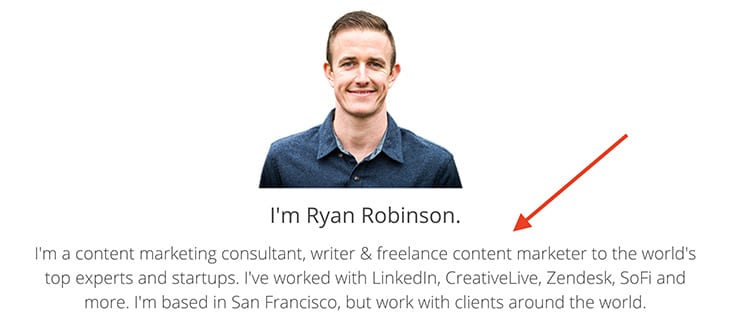
I also clearly highlight clients I’ve worked with—Tech startups in San Francisco—to encourage more of the same to want to work with me. For many reasons, picking a niche is one of the best decisions you can ever make as a freelancer.
Let’s say you own a coffee shop and you’re looking to hire someone to help you with a rebrand, coming up with new visuals, a fresh logo and marketing materials… and you’re choosing between 2 different options for freelancers who say they can help you.
Freelancer #1 is a generalist. She’s got a broad range of experience running marketing campaigns, knows how to use Adobe Photoshop & Illustrator, has made a few logos over the years and does the design work for her personal website—mostly for fun, but you like her style.
Freelancer #2 is a specialist (with a clear niche). He works for himself as a full-time graphic designer and has done branding work for several coffee shops over the years. You like his style just as much, and can tell that he’s got a lot of experience doing exactly the kind of work you need done too.
Which freelancer would you choose?
Every day of the week, I’d take freelancer #2. The specialist.
I’ll also pay them significantly more—because I know I’m tapping into expertise.
In your freelance business, you want to brand yourself as that expert with a niche. Make yourself the obvious choice. That’s step one for making sure your cold emails get answered.
Now, you’re ready to start searching for freelance clients. Start with the people you know first. As much as I love cold emails, warm introductions are significantly more effective, so begin there.
Look first to these groups of people within your network to determine if there are any freelance opportunities to work with those who already know your work ethic, are personally invested in their relationship with you and want to see you succeed:
Regardless of the exact role your connection has within the company they’re at, if that company could be a good fit for you to pitch on freelance work—that’s a great opportunity to chase down.
Pick up the phone to catch up, grab coffee and ask if they’d be willing to introduce you to the right person within their organization for chatting about helping out on a freelance basis.
At the very least, walk away from these conversations with the name for who you should be reaching out to—then you can work your cold email magic.
Continue updating the status of your outreach efforts using either a spreadsheet or an easy-to-use CRM like Close that gives helpful reminders and reporting, so you’re able to see how well your cold outreach performs over time.
When I’m trying to land a new client, I don’t want to spend time convincing a gatekeeper on the company’s HR or recruiting team that I’d be the best for the job—I’m going straight to the person who’s going to be in control of the hiring decision.
Sure, the HR gatekeepers probably have criteria they know to look for, but that leaves too much up to chance.
I want to cold email pitch someone who speaks my language.
As a content marketer (or freelance writer), my ideal point of contact at a potential client company usually has one of these job titles:
You want to go for a manager-level point of contact. The type of person who will have a say in hiring contractors for your discipline.
If you’re a freelance designer, you’ll probably be looking to connect with a creative director.
If you’re a freelance developer, your ideal point of contact will likely be a director of engineering.
Sometimes, if you can’t find a manager point of contact, making an initial (genuine) connection with someone who’s a staff writer—or designer, engineer—can lead to an introduction up the chain to their manager if you’re able to provide a significant amount of value in your cold email outreach.
What’s important is that you skip the application, and go for connecting directly with real people.
Use LinkedIn to find your ideal point of contact.
If I want to land Trello as a content marketing client, my search would look like this:
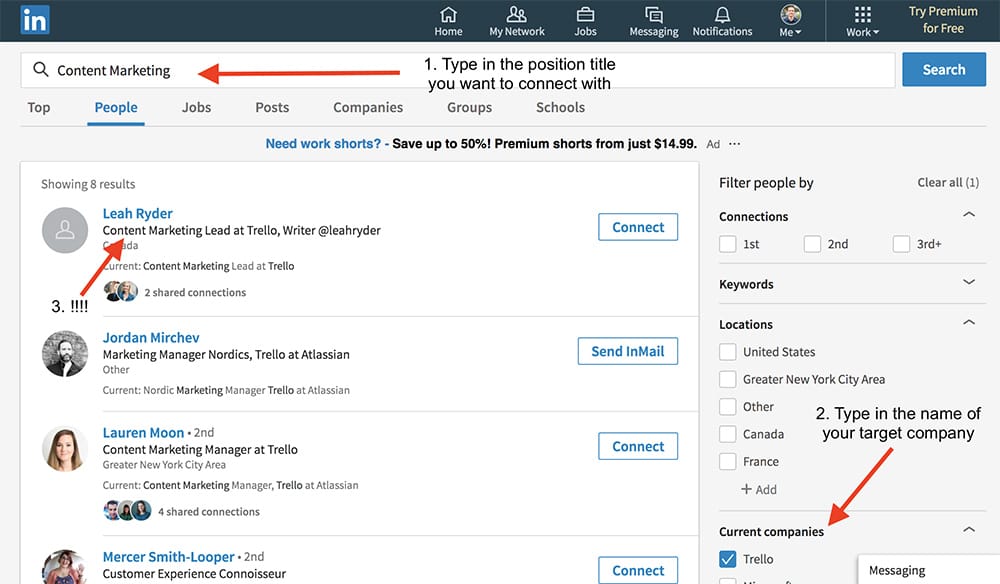
Naturally, this works best for companies within a certain size range.
If they’re on the smaller side, you might not immediately find a very clear point of contact. Same goes for enterprise-size companies that have dozens of potential points of contact.
Make your best guess and keep moving rather than getting hung up or spending more than 5 minutes at this stage.
Finding a prospect’s email address has never been easier.
Today, you can head over to any number of free email sourcing tools like Hunter or Voila Norbert, input their names, add the relevant website their email address should be located at, and almost immediately get their email addresses.
Here’s a screenshot of how easy it is to locate an email address using Hunter:
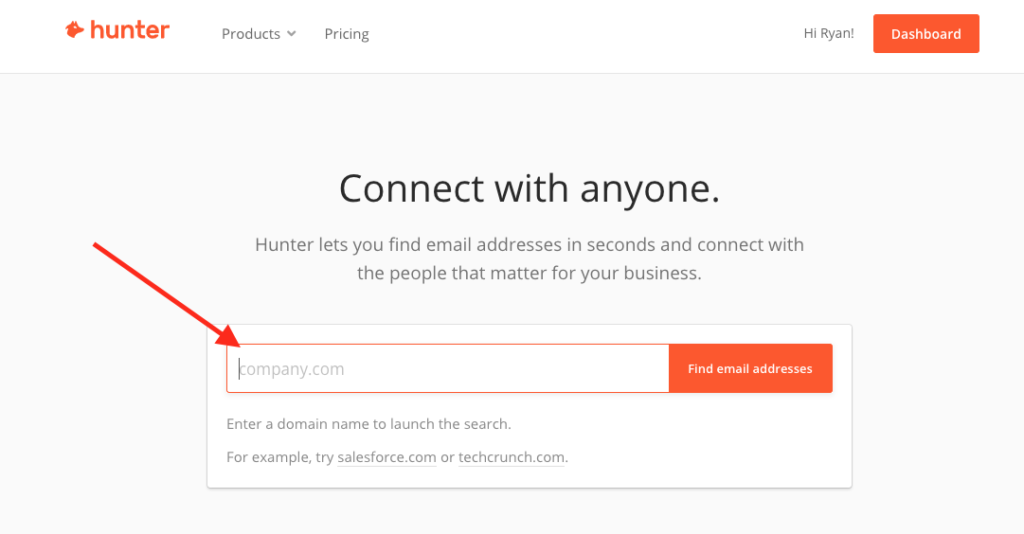
Start by typing in the URL for the company your prospect works at.
Sticking with my Trello example from earlier, if I wanted to get in touch with Leah on their marketing team to inquire about doing a content marketing project with them, I’d input trello.com into the Hunter search bar.
That’d give me a results page where I can further filter my results by adding Leah’s name to narrow down the list:
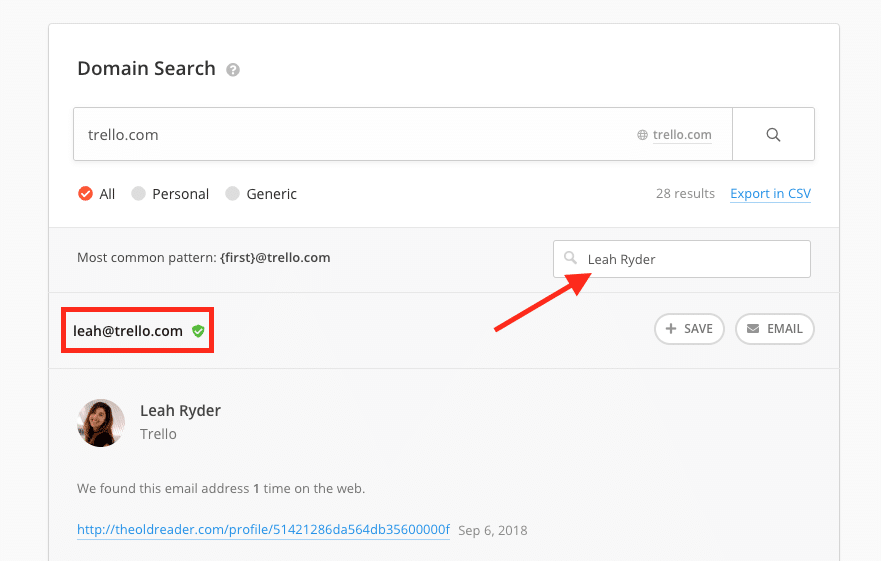
That’s it!
Even if the email finder you’re using doesn’t have your prospect’s address verified, it’ll almost always give you a recommendation for what their email address likely is, based on the most common pattern the company uses.
Alright, now that we’re on the same page, here’s a recap on where you need to be before you even get started on writing the actual cold email:
But before you go out and start cold emailing, you need to set sales goals for what exactly you hope to achieve with your cold outreach. Will you stop once you’ve landed your first client? The second? Fifth? Tenth?
Know how much work you can take on before overloading yourself.
Now we can talk about what goes into the perfect cold email for landing a freelance client, starting with an example.
As a freelancer, you need to use the tools you’ve got—and not make excuses for why you can’t land a particular client. If you go above and beyond to wow a client you’ve really been wanting to work with, you can make it happen. It’s in your power.
Don't make excuses for why you can't land a particular client. If you go above and beyond to wow a client you've really been wanting to work with, you can make it happen. It's in your power. @theryanrobinson Click To TweetFor me, long before I ever became a contributor on sites like Forbes, Entrepreneur and Business Insider that have since helped me boost my visibility, I was using my blog as my most powerful asset for leveraging freelance gigs.
This first cold email template—specifically crafted for influencers and founders—is built around using my blog as a way to provide value before I ask for anything in return.
Here’s how the process works:
At this point, some will outright ask me if I can help them create content like this for their blogs. Others I’ll need to then pitch on my content marketing services (like putting together a content marketing strategy and executing on it) if they don’t bring it up themselves.
It’s not always a good fit for everyone I ask, but because I’ve already provided value AND essentially given them a real-time demo of what my service is through the post they’re included in, my conversion rate to paid client relationship with this method is extremely high.
This email contains no promotional links. No service pitches. No asking if they’re hiring.
You need to be patient at this stage. Your goal is to provide value and show your worth.
By doing that first, instead of just making promises of the value you could deliver in the future, you’re going to win their trust and catch their attention in a much different way than 99% of other freelancers cold emailing and pitching them to be hired.
Seems simple, but almost nobody has the patience to execute this kind of in-depth sales strategy. And because of that, so many freelancers waste a lot of time writing cold emails that get no response, largely because they’re being too short sighted.
Sure it can take weeks to turn into a paid gig—and sometimes it never will—but the freelancers who take my course on learning how to pitch effectively experience massively positive results from following this strategy.
This is the cold email that netted me a $50,000+ deal:

After getting the quote from this startup founder and including him in my post, he was pumped about the thousands of shares the post had received in the first few weeks of going live (I spent $100 boosting the post on Facebook, Twitter, Pinterest & Quuu Promote to get an initial share spike).
This founder wanted those kinds of results for his startup’s blog too.
He actually beat me to the pitch—and emailed asking if I’d be up for working with him:

After a quick chat on the phone laying out my workflow and getting clear on his goals, we locked in a strategy for publishing 2 posts each month—we’ve been working together ever since.
What’s better than sending a cold email? Sending a warm one.
Compared to the first cold email template we talked about, this warm introduction strategy typically converts much quicker. It’s straight to the point and doesn’t rely on needing to first get a quote, publish a blog post, or otherwise.
I use it when I’m approaching a company that’s a bit larger and doesn’t have a clear figurehead that’d be reasonable for me to be able to connect with individually by shooting her/him an email.
This approach goes to directors and managers—not founders.
But first, it requires making a connection to another freelancer, contractor or employee at the company—which is why this process is particularly great for freelance writers when the company clearly has many contributors that write for them on a contract-basis.
Here’s how the process works:
After you’ve gotten your referral connection lined up, the template (to the point of contact at your target company) goes like this…

Less than an hour after sending that email to the freelance writer, I heard back!
We do spend most of the day sitting at computer…

Will it always be this easy? No way.
But because I went out of my way to (1) genuinely compliment her work and (2) share it with my audience on Twitter, she was willing to reciprocate that value by giving me the contact info for the decision-maker at the company.
Plus, getting her to my Twitter feed to check out her mention gave her the opportunity to see some of my work and feel confident that I wouldn’t make her look bad—because I was indeed a good fit for working with this company.
I also made it a lot easier for her to say yes by not asking for a direct introduction (takes more time) and for just contact info.
Once I got the email address for the Director of Content Marketing at this company, here’s the cold email I sent:

After sending that cold email to the Director of Content Marketing, she got back to me the same day expressing interest and wanting to hear more—including specific pitch topics I had in mind.
I sent a couple topics over and explained my “hands-on” content promotion process, walking through everything I do to distribute my posts after they go live, which is where my real value is added.
A few days go by and she gets back to me with a thumbs up 👍
Here’s that email…
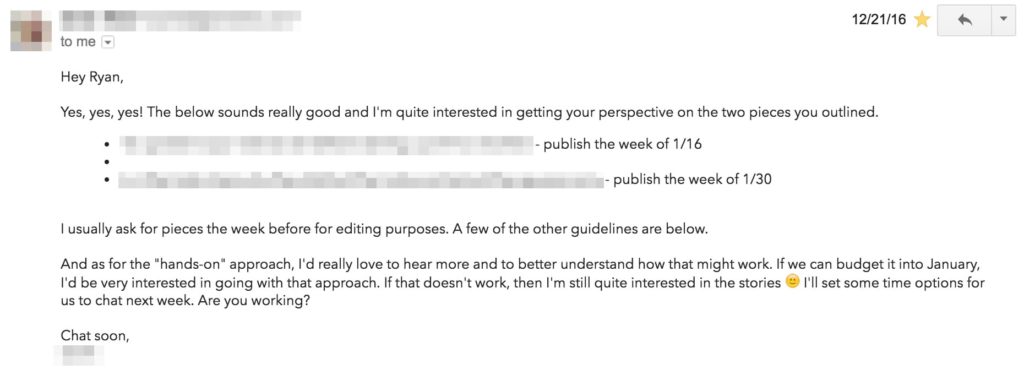
We spoke on the phone the next week and locked in the game plan for kicking off my work.
So far this year, that’s turned into an average of one article per month at $2,500/post.
The third and final template we’re breaking down in this post (that has helped me land many remote jobs as a freelancer) is much more direct than the previous two.
Because of it’s directness, it is in my experience a little more likely to get turned down or go unanswered if there’s not an immediate need (or interest) internally at the company. However, this still provides real upfront value—our recurring theme with effective cold outreach.
It still requires doing your homework to make sure you’re reaching out to the right company, identifying your decision-maker point of contact and tracking down their email address before you even get started on the actual cold email.
Here’s how the process works:
Of all the cold emails, this one is heaviest on self-promotion—in the context of building your authority with this potential client.
It also directly pitches them on working together in your first email.
Again, the goal is to get in front of the right decision-maker and get a phone call scheduled so that you can really pitch them on your services more effectively.
This is the cold email that landed me a $10,000/mo retainer contract for 4 blog posts per month:
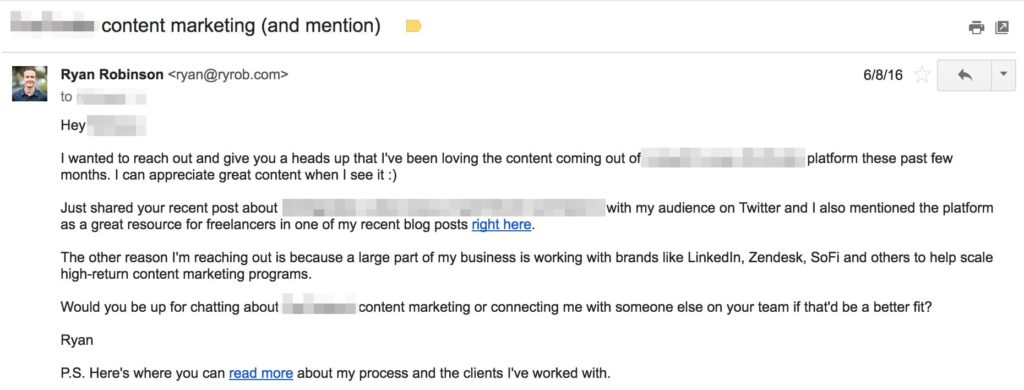
I sent this email pretty early in the morning.
By the afternoon, I’d already heard back.
Here’s that email I got from the person I reached out to, with a colleague of his cc’d…

We set up a time to chat on the phone, learn more about their goals, walk through my process and the rest is history.
I’ll be the first to tell you though, this isn’t the typical response to a cold email pitch for freelance work.
And I definitely had no expectation that it’d be a $10,000/mo deal until after we had a discovery call and I was able to feel out their budget and pricing expectations. They mentioned that they’d tried working with marketing and PR agencies in the past, but didn’t see enough results—that (coupled with the size of the company) immediately told me they’re accustomed to paying premium retainers for contract help.
All in all, out of the ~100 of these types of cold emails I sent last year, somewhere in the neighborhood of 10-15 have materialized into deals within a month of initial contact. These cold emails require more hands-on follow up too.
Here’s another hard truth about freelancing: You have to fight to get noticed.
That’s because everyone you’re pitching is busy.
If I never followed up on my cold emails (especially in the early days of freelancing), I wouldn’t stay busy. But there’s a fine line between being that annoying person who sends check-in emails every other day and allowing yourself to justify not following up simply because you haven’t heard back yet.
You have to strike a balance and provide value with your follow ups, don’t just ping your prospects with the same question every time you follow up.
Steli Efti, founder of Close (one of the best CRMs for freelancers) is a master at following up and knows the importance of never letting a lead slip away.
He shares, “I have a simple philosophy. I follow up as many times as necessary until I get a response. I don’t care what the response is as long as I get one. If someone tells me they need another 14 days to get back to me, I will put that in my calendar and ping them again in 14 days.”
What about when you send your cold email and don’t hear back for a few days?
Follow up every 3-4 business days.
When the email is truly 100% cold and you have no connection whatsoever to your prospect, limit your follow ups to around 4-5 outreach attempts. Any more than that, you’ll run the risk of seriously annoying someone and permanently burning the bridge.
If you’ve tried making contact over email at different times of the day, on multiple different days of the week for a few weeks, then give it one last shot by picking up the phone and calling to see if there’s any chance of salvaging the conversation.
After that, it’s time to move on and keep pitching new prospective clients.
And that should be exciting, because as they say, there are always more fish in the sea.
Our automated technology and intuitive tools take care of the small stuff so you can
focus on what matters